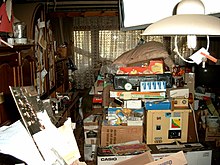|
Hoarding Hoarding is the act of engaging in excessive acquisition of items that are not needed or for which no space is available.[1] Human hoarding Civil unrest or the threat of natural disasters may lead people to hoard foodstuffs, water, gasoline, and other essentials that they believe will soon be in short supply. Survivalists, also known as preppers, often stockpile large supplies of these items in anticipation of a large-scale disaster event.[2][3] Other items commonly hoarded include coins considered to have an intrinsic value, such as those minted in silver, or gold, as well as collectibles, jewelry, precious metals[4] and other luxuries. According to previous[5] studies, anthropomorphism, or the propensity to attribute human characteristics to non-human items, has been associated with hoarding. Additionally, the findings stated that younger individuals had more substantial hoarding and anthropomorphizing cognitions and behaviors, and women demonstrated stronger early anthropomorphizing behaviors compared to men.[6] HistoryThe first documented case of hoarding was in the Collyer Mansion by the brothers Homer and Langley in 1947, New York. Their mansion became an attraction in 1938 because of the extreme level of accumulation and fortune found in their residence after their deaths.[7] Anxiety Individuals who meet the diagnostic criteria for hoarding disorder experience feelings of anxiety or discomfort about discarding possessions they do not need. This discomfort arises from an emotional attachment to possessions and a strong belief that their possessions will be needed in the future. Possessions will take on a sentimental value that outweighs their functional value. This is no different from someone without hoarding disorder; the difference lies in the strength of this sentimental value and in how many items take on a sentimental value. For this reason, when discarding items, hoarders may feel like they are throwing away a part of themselves.[8] In severe cases, a house may become a fire hazard (due to blocked exits and stacked papers) or a health hazard (due to vermin infestation, excreta and detritus from excessive pets, hoarded food and garbage, or the risk of stacks of items collapsing on the occupants and blocking exit routes).[9] Thus, hoarding affects more than just the owner of the objects, as the state of a hoarded house can have a negative effect on all occupants and even neighbors. Furthermore, individuals with hoarding disorder may have a quality of life as poor as those diagnosed with schizophrenia.[10] Eventually, the disorder increases family strain,[11] work impairment,[12] and the risk of serious medical conditions.[13] Hoarding disorder begins at an average age of 13 years old.[14] The general consensus is that men and women are equally prone to hoarding.[15] Hoarding can run in families, and it may be possible genetics play a role in developing hoarding behaviors.[16] Also, this behavior can be developed due to life circumstances such as difficult losses, depression, financial crises, and living small which make it difficult for people to get rid of their belongings.[14] According to the Diagnostic and Statistical Manual of Mental Disorders,[17] the criteria for hoarding disorder boils down to five main points. Firstly, the hoarder experiences difficulty parting with items regardless of the item's value. Secondly, the hoarder feels a need to save items, and when they do part with them, it leads to strong distress. This, in turn, leads to objects cluttering the home to the point that living is compromised and rooms cannot be used for their intended purposes. If the house has not fallen into such a state, it is only because of outside parties intervening. Fourthly, the hoarding has compromised the hoarder's life in a clinically significant way, including an inability to maintain a safe living environment. Lastly, the diagnosis is only given if another psychological diagnosis does not fit better and there is no physiological reason to explain the hoarding. For an exact quote of the diagnostic criteria, the Diagnostic and Statistical Manual of Mental Disorders is available to the public.[18] TreatmentThere are no medications currently approved by the Food and Drug Administration for treating the symptoms of hoarding. Although, some medications, such as selective serotonin reuptake inhibitors (SSRIs) and serotonin/norepinephrine reuptake inhibitors (SNRIs), can be used off-label for individuals diagnosed with hoarding disorder.[19] The primary treatment for hoarding disorder is individual psychotherapy. In particular, cognitive behavior therapy is regarded as the gold standard for treating the disorder.[20] In literatureIn the Divine Comedy, those who hoard are depicted as sinners locked in eternal battle with wasters. Overseen by Pluto (the former god of wealth now turned into a demon and that speaks in gibberish) they have to push heavy boulders (representing money) in opposite direction, each time the two lines of sinners meet they accuse and insult each other. The hoarders and wasters have been condemned to Hell for being unable to practice moderation with money.[21] In William Shakespeare's play Coriolanus, Caius Marcius and his followers hoard grain, only sharing it with those they deem worthy.[21] See also
References
Further reading
External links |